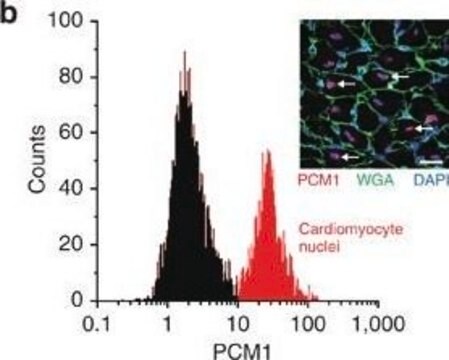Wichtige Dokumente
SAB4200753
Anti-phospho-AKT (pThr450) antibody, Mouse monoclonal
clone AK-11, purified from hybridoma cell culture
Synonym(e):
Anti-Protein Kinase B, Anti-V-Akt Murine Thymoma Viral Oncogene Homolog 1
About This Item
Empfohlene Produkte
Biologische Quelle
mouse
Qualitätsniveau
Antikörperform
purified from hybridoma cell culture
Antikörper-Produkttyp
primary antibodies
Klon
AK-11, monoclonal
Form
buffered aqueous solution
Mol-Gew.
~56 kDa
Speziesreaktivität
mouse, chicken, rat, human
Konzentration
~1.0 mg/mL
Methode(n)
immunoblotting: 1-2 μg/mL using human breast cancer cell line MCF-7 extract
immunofluorescence: 1-2 μg/mL using mouse embryo fibroblast NIH-3T3 cells
immunoprecipitation (IP): 2-4 μg/test using whole extract of mouse embryo fibroblast NIH-3T3 cell line
Isotyp
IgG2a
UniProt-Hinterlegungsnummer
Versandbedingung
dry ice
Lagertemp.
−20°C
Posttranslationale Modifikation Target
phosphorylation (pThr450)
Angaben zum Gen
human ... AKT1(207)
Allgemeine Beschreibung
Spezifität
Immunogen
Anwendung
- immunoblotting
- immunofluorescence
- immunoprecipitation
Biochem./physiol. Wirkung
Physikalische Form
Lagerung und Haltbarkeit
Haftungsausschluss
Sie haben nicht das passende Produkt gefunden?
Probieren Sie unser Produkt-Auswahlhilfe. aus.
Lagerklassenschlüssel
10 - Combustible liquids
WGK
WGK 2
Flammpunkt (°F)
Not applicable
Flammpunkt (°C)
Not applicable
Analysenzertifikate (COA)
Suchen Sie nach Analysenzertifikate (COA), indem Sie die Lot-/Chargennummer des Produkts eingeben. Lot- und Chargennummern sind auf dem Produktetikett hinter den Wörtern ‘Lot’ oder ‘Batch’ (Lot oder Charge) zu finden.
Besitzen Sie dieses Produkt bereits?
In der Dokumentenbibliothek finden Sie die Dokumentation zu den Produkten, die Sie kürzlich erworben haben.
Unser Team von Wissenschaftlern verfügt über Erfahrung in allen Forschungsbereichen einschließlich Life Science, Materialwissenschaften, chemischer Synthese, Chromatographie, Analytik und vielen mehr..
Setzen Sie sich mit dem technischen Dienst in Verbindung.